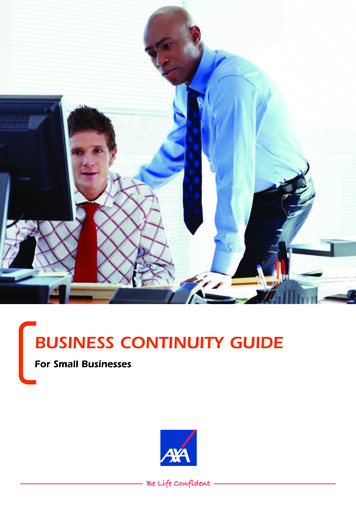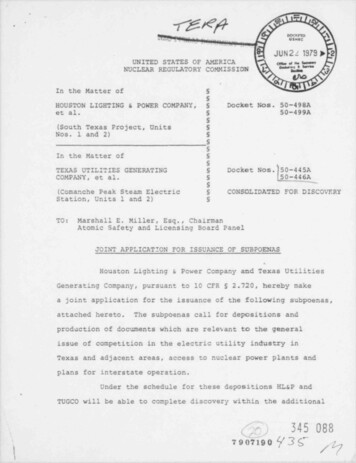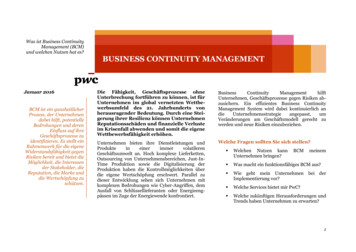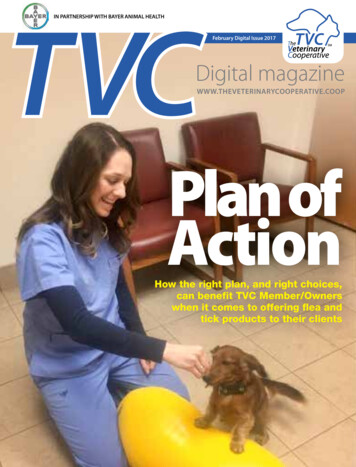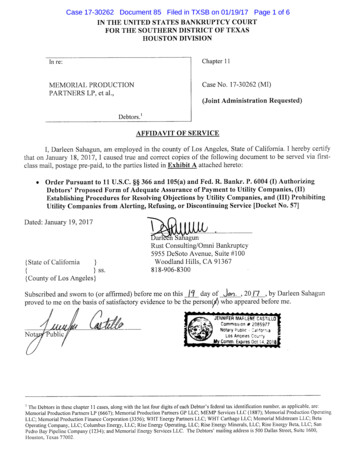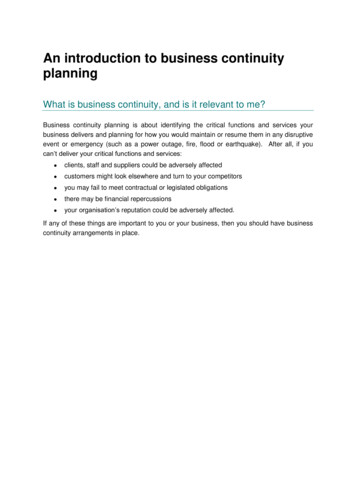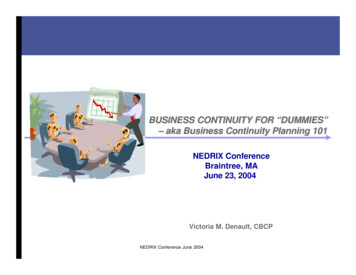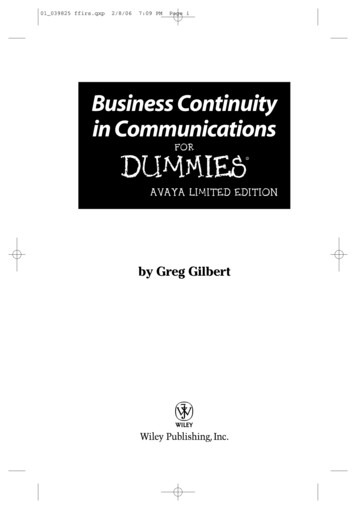
Transcription
Continuity ofOperations (COOP)Planning Template andWorksheets2014
Continuity of Operations PlanningYou have invested significant time and resources into making your agency a success. Youragency is important to you; your family, your employees, and the people you serve. It isimportant to take the time and effort necessary to plan to protect your investment. ThisContinuity of Operations (COOP) Planning template has been developed to serve as a road mapin building your agency’s plan to prepare for, and respond to any event that disrupts youroperation. Throughout the template, worksheets1 are referenced. These fillable documents arelocated at the back of the template and can assist in the creation of your agency’s COOP.Developing the PlanCOOP planning must be reasonable, practical, and achievable. You are not planning for everypossibility that could cause an interruption. Instead your agency is planning for the effects ofany interruption. For example, your building may be unavailable for many reasons (fire, flood,tornado, etc.), but the effect is still the same: you cannot work in that location. Or your buildingis accessible, but electricity or internet access may be unavailable for several days, or half ofyour workforce is ill due to an influenza outbreak, all of which could interrupt your agency’sability to perform essential functions.The first step in developing your agency’s COOP is to create an employee planning team usingstaff from all areas of your agency. By involving employees in your planning efforts, you willkeep them engaged in the planning process, they will know and understand your plan, and theywill be able to share your planning message with other employees. When an incident occurs,you will have pre-trained employees ready to put your plan into action.Use the following pages as a template to create a basic, functional COOP plan. The templatemay be expanded to meet your agency’s needs, but it is important to address these primary areas: Record of ChangesSignature of AdministratorOrders of SuccessionDelegation of AuthorityDetermination of Essential FunctionsPrioritize Essential FunctionsIdentify Staff Performing Essential FunctionsCreate Drive Away KitsInventory of Vital RecordsNotification of Staff and Business PartnersAlternate WorksitesTraining and ExercisesFor additional guidance, please contact the Missouri State Emergency Management Agency(SEMA) 573-526-46781The worksheets use ‘tables’ in Microsoft Word. You may add as many rows as needed to your worksheet by highlighting a row and insertingextra rows (right click on the highlit area and choose ‘insert’).i
Continuity of Operations(COOP)PlanForAgencyDateii
COOP Plan Record of ChangesPublication Change History: All components of the COOP Plan should be reviewed, ata minimum, on an annual basis and any revisions should be made to all maintained copiesand disseminated as necessary. Changes made to the COOP Plan should be documentedin the following Record of Changes.Page #Description of ChangesRevisedRevision DateiiiCreated by/Changed byRequested by
Table of ContentsPage:Executive Summary .Purpose of COOP .Leadership . Mission Essential Functions .Go Kits . Vendor Information and Restocking Plan . Vital Records, Files, and Databases . Activation, Notification, and Relocation . Notification and Communication . .Alternate Work Sites . Return to Normal Operations . .Training, Exercise, and Evaluation .Definitions . .WorksheetsA: Orders of Succession and Delegation of Authorities . B: Determine Essential Functions C: Prioritize Essential Functions .D: Essential Functions Staff .E: Go Kits .F: Vendor Information and Restocking Plan G: Inventory of Vital Records .H: Staff Calling Tree (Table Style) .I: Staff Calling Tree (Organizational Chart Style) J: Communication Plan with Partners .K: Alternate Work Site Requirements .L: Alternate Work Site Options M: COOP Plan Training Program .N: COOP Plan Exercise Program .iv14151617181920212223242526271233556679101012
Executive SummaryThe mission of the agency in Continuity of Operations (COOP) planning is to utilize allavailable resources to maximize contribution to the overall continuity of operationsresponse effort while assuring essential functions.Insert a brief statement of what the agency is responsible for.Following emergencies, disasters, or other events—deliberate, accidental, or resultingfrom natural events—agency is responsible to provide specific essential functionsrecognized in this plan.Signature of Administrator/DirectorDate1
Purpose of COOPThe purpose of the Continuity of Operations (COOP) plan is to establish policy and guidance toensure that essential functions for an agency are continued in the event that manmade, natural, ortechnological emergencies disrupt or threaten to disrupt normal operations. The COOP planenables the agency to operate with a significantly reduced workforce and diminished availabilityof resources, and to operate from an alternate work site should the primary facility becomeuninhabitable.COOP plans should be activated when:1. An incident occurs requiring relocation of any essential functions (buildingcompromised)2. Essential functions are significantly compromised3. Staffing levels are significantly compromised (i.e. influenza pandemic)4. Key partners are not available for normal operations5. Essential systems are unavailable (power, water, information technology).The COOP plan does not apply to temporary disruptions of service during which servicesare anticipated to be restored within a short period of time.Individual and Family PreparednessIt is very important for staff to be prepared and know what to do in times of emergency,and equally important that their families are cared for and prepared. Information for howto plan for an emergency can be accessed Ready in 3 includes three steps:1. Create a plan for you, your family, and your business2. Prepare a kit for home, car, and work3. Listen for information about what to do and where to go during an actualemergencyCreating and exercising an individual and/or family plan will provide peace of mind foryour employee’s entire family. Utilizing the “Ready in 3” program to prepare their familyfor emergencies will give staff greater peace of mind if they need to report to work duringa COOP activation. A staff member is more likely to report to work if their family is ableto care for themselves during an emergency.2
LeadershipOrders of SuccessionList authorized successors for leadership in Worksheet A. Lines of succession should bereviewed and updated routinely to ensure continuity of essential functions. Desk manuals, JobAction sheets, and cross trained staff are recommended for all essential functions.Delegations of AuthorityDelegations of authority will follow the orders of succession. If the Director is unavailable for asustained period of time, the second individual will be delegated the authority to act on behalf ofthe Director. If first and second individuals are unavailable for a prolonged period, the thirdindividual will assume the primary authority, and so on.Worksheet A Instructions: In the first column, list key decision-makers (by position) responsiblefor the agency’s essential functions (see Worksheet B to determine essential functions). In thesecond column, list the designated successors for each decision-maker. It is important to list twoto three backup successors. In the third column, specify whether the key decision-maker’sauthorities to perform all functions are transferred to the successor or whether there are somelimitations (e.g., authority to spend up to X without authorization). In the fourth column,identify the circumstances under which the successor’s authority is activated and terminated. Inthe last column, note where the authority, including when it is activated and terminated, isrecorded.Complete Worksheet AMission Essential FunctionsThe agency must identify and prioritize its essential functions so the mission may be carried outduring an emergency or COOP incident. Any task not deemed as an essential function will bedeferred until additional personnel and resources become available.Prioritization and StaffingDetermine your agency’s essential functions with Worksheet B.Worksheet B Instructions: List all of the agency’s functions and indicate whether each functionis essential to continue or could be deferred during an incident/emergency resulting in irreparabledamage and widespread systems disruption. To determine whether a function is essential,consider whether it is statutorily mandated, vital to the agency’s mission, critical to maintainsafety (e.g., food service inspections), and/or necessary to the performance of other agencyfunctions (e.g., maintaining/accessing databases to process payroll). If a function is consideredessential, list the reason(s) why in the last column.Complete Worksheet B3
The essential functions are prioritized using the following definitions:1. Immediate: Mission-essential functions that must be performed immediately after adisruption.2. Day: Mission-essential functions that must be performed, given a one day disruption.Not considered immediate, but must be performed within 24 hours. (Ranked fromhighest to lowest priority.)a. After one day of emergency operations, either normal operations must bereinstated or emergency operations must ensure the functions listed in #3 beloware performed.3. Week: Mission-essential functions that must be performed, given a disruption of greaterthan one day but less than one week. (Ranked from highest to lowest priority.)a. After one week of emergency operations, either normal operations must bereinstated or emergency operations must ensure the functions listed in #4 beloware performed.4. Month: Mission-essential functions that must be performed, given a disruption ofgreater than 1 week but less than 1 month (ranked from highest to lowest priority).a. After 30 days of emergency operations, all functions should be resumed at normaloperations level.b. If normal operations cannot be resumed in 30 days, the agency may considerentering devolution agreements with other agencies/organizations.Determine the essential function’s recovery time and prioritization on Worksheet C.Worksheet C Instructions: List essential functions from Worksheet B in column 1. In column 2,specify the time period within which the function must be back online during anincident/emergency using these categories: Immediate; Day ( 24 hours); Week ( 1 day, 1week); or Month ( 1 week, 1 month). The time period should be consistent with statutoryrequirements and or agency policy, if available. For functions not specified in statute, rules, orpolicies, the time period should be based on a combination of (a) how critical the function is tothe agency’s mission during an incident/emergency, (b) how long the agency can operate withoutperformance of the function, and (c) how important the function is to the performance of otheressential functions (see the third column in Worksheet B for reasons why specific functions areconsidered critical). Consider what functions must occur over extended holiday weekends andwhat can wait. A function probably shouldn’t be in the Immediate or Day category if it can waituntil after a holiday. For column 3, rank the priority of each essential function within theirrecovery time. (e.g., Day prioritize 1, 2, 3 .; Week prioritize 1, 2, 3 and so forth).Complete Worksheet C4
Essential functions cannot be performed without staff. Associate the necessary positions and/oremployees with each essential function on Worksheet D.Worksheet D Instructions: Using Worksheet C, list the agency’s essential functions, generally inorder of recovery time and priority in the left column. In the middle column, list the positiontitles of all staff needed to perform the essential function. In the right column, list any additionalstaff that don’t routinely perform the essential function but can be used if necessary because theyhave received appropriate training. The contingency staff should be considered carefully if theirprimary duties are dedicated to another essential function. (Names of staff are optional, but ifused, the plan must be kept up to date.)Complete Worksheet DGo KitsEach essential function should have a Go Kit (a.k.a. Drive Away Kits) in the event the functionmust relocate quickly. These kits contain only items that are vital to the performance of thefunction. A kit may be a simple as a portable electronic storage device (flash drive) with all themanuals, forms, contacts, and links necessary to perform the function, even if this data is on aduplicate server or cloud service. The kit may also be a physical box or bag with manuals,supplies, equipment, etc. that are necessary to perform the function. One should not rely on thepresence of technology and should consider a manual work around. One should considerkeeping the kit at an alternative location to assure access if your building becomes compromised.It is very important to keep the information contained in the kit up to date. Worksheet E can beused to document the contents of each kit.Instructions for Worksheet E: Go-Kits include only items vital to the performance of theessential function. (The items that are not pre-positioned and maintained at an alternate site.) Thefirst column provides the types of items that could be included, the second column identifies thespecific items necessary to the essential function’s duties, and the third column records the lasttime the contents were reviewed and/or updated. Portable storage media, such as flash drives, aregreat tools for Go Kits, especially if stored offsite, it is critical to keep them updated. Create aworksheet for each essential function.Complete Worksheet EVendor Information and Restocking PlanDuring a COOP incident, it is important to have a plan of how to obtain or maintain theequipment and supplies necessary to perform essential functions. Use Worksheet F to documentthe vendor’s contact information, the types of services, equipment, or supplies provided, andother relevant information.Instructions for Worksheet F: Enter information about the vendors supplying the items listed onWorksheet E. It is important to know how to restock your supplies, how to obtain additionalequipment, and who to contact for emergency repairs during an incident. Examples are in italics.Complete Worksheet F5
Vital Records, Files, and DatabasesAs used in COOP planning, the term “vital records” refers to documents and databases that mustbe available to support an agency’s essential functions. (Not to be confused with Birth andDeath records administered by the health department.) Vital records include the databases thatsupport the records. Use Worksheet G to document the necessary files, records, or databaseswith a description, location, supporting applications (what software is necessary to open the file,)how it is maintained, and any back up or protections in place.Instructions for Worksheet G: In the first column, list the essential functions by priority asidentified in Worksheet C. In the second column, list any vital record necessary for performingthe essential function, and briefly describe each record in the third column. In the fourth column,list each form of the record and its location (e.g., paper files in personnel office, electronicversion on network, backup of electronic files on flash drive in drive-away kit). List anysupporting software or hardware needed to access each record in the fifth column. If some vitalrecords are not backed up and stored in more than one location, stored in risky areas (e.g., abasement likely to flood), or stored on media inaccessible at the alternate facilities; the teamshould identify additional measures to protect the files and ensure accessibility to essentialfunctions staff in the last column of the Worksheet.Complete Worksheet GActivation, Notification, and RelocationThe Director or successor/designee is responsible for activating the COOP and for providingguidance and direction during COOP activation and potential relocation.The extent of actions required once the COOP plan is activated will depend on how severely theevent impacts the physical facilities; whether personnel are present in the occupied work spaces;and which functions were impacted by the incident. When activating your agency’s COOP, thefollowing priorities are useful to remember: Protecting Personnel Internal and External Communications Maintaining Essential Functions Timely Recovery and Resumption/Restoration of Services.Execution with Warning, during Business HoursUpon receipt of an alert from the Director, or designated representative, other managers beginpreparations to provide essential function services within the context of the COOP incident. Thismay include relocating all, or part of staff assigned to essential functions to alternate facilities.Staff may be reassigned to assist in other positions or locations, or they may be directed to gohome.6
Upon receipt of COOP activation alert notification, personnel perform the following: Assemble supporting elements required for re-establishing and performing essentialfunctions such as vital records, software and hardware, Go-Kits, and other documents andequipment; Back up essential automated databases not backed up since the last update; Prepare designated communications and other essential equipment for relocation; and Take appropriate preventive measures to protect all communications and equipment notdesignated for relocation.Execution without Warning, during Business HoursIf the decision occurs during business hours that a building housing staff is not usable, specificactions depend on the extent of damage to the building. Employees shall take steps to contacttheir supervisor, who will direct employees in the actions they should perform. Employeesshould not just leave work without checking with their supervisor, or their supervisor’ssupervisor (employees should follow the chain of command). Employee safety should always bethe priority.After a reasonable time to organize the COOP response, the Director or designee willcommunicate the plan to resume essential functions. Depending on the specifics of the incident,personnel may be directed to implement parts or all of their COOP plan to resume essentialfunctions from an alternate facility until offices can be reoccupied.Execution without Warning, during Non-Business HoursUpon the decision, during non-business hours, that a building housing staff is not usable, theDirector or designee notifies employees via Staff Calling Tree or if available, an automatednotification system.Notification and CommunicationNotification of StaffCommunication with internal staff will occur utilizing the agency’s normal method of notifyingstaff of emergencies. One potential method to use includes the calling tree method. A commonpractice is to follow the agency’s organizational chart. Supervisors contact those they supervise.If contact is not made with a supervisor, proceed to contact the staff that report to him/her.Include multiple numbers in the call list. Email addresses could also be added. This can be donemanually or with an automated system, if available. Consider other notification methods ifphones are not functioning such as: E-mail; Agency Website Radio and television Runners able to convey written and verbal communications Couriers deployed between facilities, other locations Twitter, Facebook, other social networking sites (if appropriate).7
Use either Worksheets H or I to develop your Staff Calling Tree. If an automated emergencynotification system is used, include a reference to the instructions and/or policy here.Instructions for Worksheet H: The individual who initiates the calling tree is listed in columnone, row one, generally the agency administrator or their designee. List all of the staff the callercalls including all of their contact information. (Add additional columns if necessary.) If any ofthe staff the initial caller contacts is responsible for calling others, list them again under the Callercolumn and add who they contact, and so on.Complete Worksheet HInstructions for Worksheet I: This worksheet is created with text boxes and arrows withinMicrosoft Word and serves more as an example than functioning template. You are encouragedto use the software routinely used to create your agency’s organizational chart or take the existingorganizational chart and add contact information. Note, in this example, the double lined boxesindicate supervisors and the lines and arrows point to who is called by that supervisor. Theindividual who initiates the call is generally at the top.Complete Worksheet ICommunications Plan with PartnersUpon activation of the COOP plan, it is important to notify and communicate with otheragencies, business partners, Emergency Management, Board of Directors or CountyCommission, as well as the people you serve. Use Worksheet J to document who your partnersare, who should notify them, and the methods that could be used to communicate the activationof the COOP. Worksheet H could be used if a Calling Tree method is used to contact partners.Instructions for Worksheet J: Identify the position responsible for coordinating communicationsduring an emergency. In the first column, list all the parties (other than staff) to contact if it isnecessary to activate the COOP plan. In the second column, list several alternative methods fornotifying each party. In the third column, identify who notifies each party. In the case of a phonetree, list who initiates the contacts. In the final column, identify additional information tofacilitate communications (e.g., location of contact information). Don’t forget to notify thepeople you serve and the general public. Examples are in italics.Complete Worksheet J8
Alternate Work SitesIt is best to identify potential “Alternate Work Sites or AWS” before an emergency/disasteroccurs. The Director or designee should be assigned to find potential AWS.Potential alternate work sites should minimally include: Restrooms IT connectivity and support Lighting Cost Phones Liability issues Table/ChairsIt is best to enter into either a written agreement or Memorandum of Understanding with thefacility owner to use their facility as an AWS in the event you need to activate your COOP andrelocate to an alternate site. As a part of local governmental operations, some Local PublicHealth Agencies (LPHA) may already be included in the local government COOP plan withAWS pre-designated by the county. The LPHA simply needs to know whom to contact incounty government to establish the AWS. Use Worksheet L to assist in completing this task.Alternate Work Site RequirementsUse Worksheet K to document the requirements of each essential function in order to operatefrom an alternative location. Consider whether the function can be accomplished bytelecommuting staff and/or can connect to the agency’s network via Virtual Private Network(VPN) or other means. If applicable, include a reference to remote access instructions/protocolhere.Instructions for Worksheet K: In the first column, list all the essential functions recorded onWorksheet D. In the second column, record the number of essential staff for each function (alsoon Worksheet D). In the third column, note whether each function can be done manually orrequires a power source(s); in the fourth column, list the types of furniture and office equipment(e.g., desks, chairs, computers, copy and fax machines) needed; and in the fifth column, identifycommunications needs such as land lines, cell phones, satellite, two-way radios, network access,and internet access. Give an estimate of the floor space needed to accommodate the staff for eachfunction and note in the last column whether telecommuting is an option for accomplishing thefunction.Complete Worksheet KAlternate Work Site OptionsUse Worksheet L to document pre-determined potential alternative work sites. Include the nameand location of the site, along with any known specifications such as size, power, connectivity,parking, etc. Also include what type of financial or other agreements necessary to secure thefacility.Instructions for Worksheet L: In the first column, list each potential alternate site identified.When visiting the facility, record the following specifications and considerations: (a) the numberof staff it can accommodate; (b) what type of power supply it has and the number of accessible9
outlets; (c) the number of desks, chairs, computers and other types of office equipment andwhether there are any private offices available; (d) the types of phone and data lines available;(e) Wi-Fi available; (f) the floor space available and whether it is contiguous or on different floorsor in separate wings; (g) how accessible the facility is for staff and public—whether parking isavailable at the facility; and (h) whether it is vulnerable (e.g., in a flood zone or near hazardmaterials storage). In the last column, list what type of financial or other agreements would benecessary to secure the facility as an alternate site.Complete Worksheet LReturn to Normal OperationsReconstitution – Is the process by which surviving and or replacement organization personnelresume normal agency operations from the original or replacement operating facility.Reconstitution procedures begin when the Director or designee determines that the situation hasended and is unlikely to recur, and then implements one of the following options: Continue to operate from the current alternate facility site, AWS, (perhaps because thebuilding normally housing the agency remains unusable or functions cannot beinterrupted to relocate to another location); Move some (or all) relocated personnel from the Alternate Work Site to a morepermanent location (perhaps because the building normally housing the agency remainsunusable, and apparently the agency must operate from a secondary location for aprolonged period of time); or The agency office has been inspected and is safe to return to. Begin an orderly return toagency office, minimizing disruption of normal activities.Devolution – The transference of rights, powers, property, or responsibility to another;especially: the surrender of powers to local authorities by a central government. If it isdetermined that the agency cannot perform certain functions as required, it may be necessary totransfer or outsource those responsibilities to another agency or partner.Training, Exercise, and EvaluationTrainingImportant components of any COOP includes; training, exercise, and evaluation. It is notenough to develop your agency’s COOP, your staff needs to be trained in how to utilize andactivate the COOP. Consider a training program that will include: (1) on-site visits to AWS toensure that all personnel are familiar with the location and contents of the COOP plan; (2)training necessary to ensure that all personnel (including contingency staff) are able to performtheir essential functions from the alternate facility site or other remote locations such ashome/telework; and (3) individual training to ensure proficiency in specialized subject areas.All newly employed staff should receive training on the contents and execution of the COOPplan within 30 days of employment start date.Use Worksheet M to document the agency’s Training Program.10
Instructions for Worksheet M: List the kinds of training (e.g., orientation, refresher course,subject-specific information for different audiences) needed in the first column, the recipients ofthe training in the second column, the method (e.g., face-to-face meeting, in-person trainingsession, broadcast session, Web-based program) for delivering the training in the third column,and the frequency with which the training will occur in the last column. Examples in italics.Complete Worksheet MExercise/TestingAfter staff has been trained to utilize and activate the COOP, it is important to exercise theagency’s COOP. Exercising or testing is to ensure correct operation of all equipment,procedures, functions, and systems that support the organizational infrastructure.Regularly scheduled testing of agency equipment, systems, functions, and procedures used tosupport the agency during a COOP event will: Evaluate ability to access and use vital records, data systems and managementsoftware/hardware, communication systems, and other equipment necessary to performessential functions; Test backup data and records required for supporting essential functions at alternatefacilities or locations to assure they are sufficient, complete, and current; Evaluate workspace, logistical support and services, and infrastructure systems, e.g.,water; electricity; heating; ventilation; air conditioning at alternate facilities; Test the completeness and usability of drive away kits (Go-Kits) and add any missioncomponents; Evaluate the ability to assign and perform essential functions in an efficient mannerIt is important that contingency staff participate in exercises in their COOP role of “primarystaff.”Use Worksheet N to document the agency’s Exercise/Testing Program.Complete Worksheet NEvaluationEach activity should be evaluated and the results incorporated into an evaluation and correctiveaction process. The results are intended to improve the overall effectiveness of the CO
1 Executive Summary The mission of the agency in Continuity of Operations (COOP) planning is to utilize all available resources to maximize contribution to the overall continuity of opera
